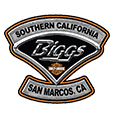How To Corner On A Motorcycle
 Whether you’re just starting out or you’ve been biking for years, cornering is a vital skill for any rider. Retaining as much speed as possible is a nice bonus, but the real goal is control and safety. Knowing how to corner properly can be the difference between losing a few mph and flying off your motorcycle entirely.
Whether you’re just starting out or you’ve been biking for years, cornering is a vital skill for any rider. Retaining as much speed as possible is a nice bonus, but the real goal is control and safety. Knowing how to corner properly can be the difference between losing a few mph and flying off your motorcycle entirely.
We want to help you stay as safe and fast as possible, so we here at Biggs Harley-Davidson® in San Marcos, California, have put together a few tips to keep you cornering properly. If you have other questions about riding, you’re looking for a new bike, or you need to bring your current one in for servicing, stop by our store today!
Counter Steering
You might assume that to turn, one simply steers in the direction of that turn. However, counter-steering is a vital technique that seems counterintuitive, but actually makes your turns both faster and safer. Essentially, you start your turn by steering in the opposite direction of the turn before continuing into the turn itself. For example, if you’re about to turn left, you start by steering just a little to the right before you begin the actual turn.
This allows you to make a much tighter turn. Where a normal turn takes time to get the lean and angle correct, counter-steering forces your bike into the desired lean early, allowing you to turn faster and more precisely. We recommend you learn more about this technique before attempting it, if you haven’t yet, in order to make sure you do it safely.
Handling The Corner
When you see a turn coming up, it’s important to pick your entry line into the corner. If there are any obstacles on the road like brake bumps, you may want to go wider. As you approach the corner, make sure to brake slightly to lower your speed. You’ll likely be in the standing position, and when you start going through the corner itself, lean forward slightly to transfer your body weight to the front of the motorcycle.
As you lean into the corner, raise your inside leg up and forward with your toes pointed down. This shifts the center of gravity inwards, which lessens the amount of lean necessary, while still keeping your upper body in line with the bike to control the torque.
You may want to practice foot positioning on your bike so you can easily lift yourself up and from side to side without disturbing your overall balance. Remember to avoid using the handlebars for weight transfer, instead relying on the foot-pegs to leverage your legs.
Body Position
Once you’re mastered seated cornering, you may want to experiment with central standing position while turning around a bend. This technique can be useful, especially on trails you’ll be standing on often. Additionally, standing cornering is great for saving energy and pushing through corners even faster. It can be a bit more dangerous, though, so proceed with caution.
Changing Gears
When turning, use a gear that gets you smooth power. When you start to accelerate out of the turn, employ steady throttle control and work the clutch. This gets power to the ground without losing rear wheel grip.
Keep An Eye Out
This may seem like obvious advice: stay aware of your surroundings. But as basic and common sense as it seems, there is no more important advice. The other tips we’ve outlined are only useful if you know exactly where you, the road, and any obstacles are at all times. Watch out for bumps and obstacles, avoiding them entirely when you can or being extra cautious going over them when you can’t. It’s natural to focus a few meters ahead of your front tire, but looking further ahead can help you be prepared for any unexpected changes or traffic flows. Scan far ahead regularly and with the speed of your bike in mind. Your body and bike will naturally follow that focus.
We hope you found some of these tips useful! If you want more advice or you’re looking to buy, stop on by Biggs Harley-Davidson®! We proudly serve San Diego and Oceanside, California, with all your biking needs. Let us serve you today!



